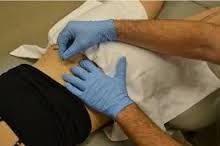Dry needling performed by Physical Therapists has grown in popularity over the past 10 years among researchers, clinicians, and patients. Dry needling uses a solid monofilament needle designed to disrupt the the taut band of muscle tissue causing a patient’s pain. This intervention uses a mechanical stimulus to create a neurological, chemical, and circulatory response leading to decreased pain, improved range of motion and function. Previous research has shown dry needling is more effective than placebo needling for reducing pain, but there is limited data on the long term effectiveness of this Physical Therapy treatment.
A recent literature review was published in the Journal of Orthopedic and Sports Physical Therapy examining the effectiveness of trigger point dry needling, performed by physical therapists, on pain and function (Gattie et al. 2017). The authors found moderate quality evidence supporting the use of dry needling for the short term treat of pain and pain tolerance. Smaller effect sizes were noted for improving patient function after dry needling treatments. These results were held up up to 12 weeks, the length of the study, but long term research is needed to determine how dry needling impacts patient symptoms at long term follow up. Dry needling is best utilized as part of a physical therapy treatment plan including manual therapy and exercise. This treatment allows for a quick reduction in pain and a transition to more active physical therapy interventions.

